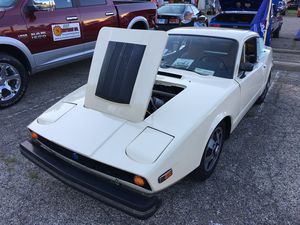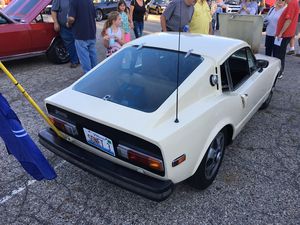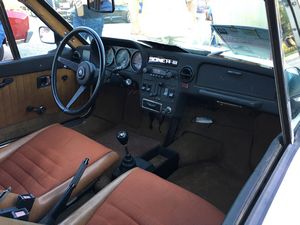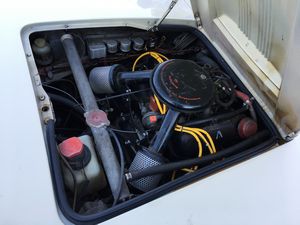















Saab Sonett |
|---|
|
| Topic Navigation |
|---|
|
Wikipedia: Saab Sonett
Page Sections History Photographs |
History
The following section is an excerpt from Wikipedia's Saab Sonett page on 26 April 2018, text available via the Creative Commons Attribution-ShareAlike 3.0 Unported License.
The Saab Sonett is an automobile manufactured between 1955 and 1957 and again between 1966 and 1974 by Saab of Sweden. Sonetts shared engines and other components with Saab 96s and 95s of the same era.
The first prototype, now known as the Sonett I, was a two-seat, open-top, lightweight roadster racer which, ten years later, evolved into the commercially distributed Sonett models II, V4, and III.
Sonett I
In the 1950s, Rolf Mellde—a Saab engine developer and race enthusiast—along with Lars Olov Olsson, Olle Lindkvist, and Gotta Svensson, designed a two-seat roadster prototype in a barn in Åsaka, near Trollhättan (the site of the main Saab manufacturing facility). The limited research-and-development project, with a total budget of only 75,000 Swedish kronor, became known as the Sonett, a name derived from the Swedish phrase Så nätt den är ("how neat it is", or more literally "it's so neat").
The Saab Sonett, also called the Super Sport or Saab 94, was introduced on 16 March 1956 at Stockholm's Bilsalong (motor show). Featuring a three-cylinder 748 cc two-stroke engine generating 57.5 horsepower (42.9 kW) and a 70 kilograms (150 lb) aluminium box-style chassis from Swedish designer Sixten Sason, the Sonett I was an advanced low-weight 600 kg (1,323 lb) racer based on aircraft design concepts.
With a projected top speed of 120 mph (190 km/h), the Sonett I had the prospect of success on the European race circuit, and a production run of 2,000 units was planned for 1957. However, race competition rules changed, permitting modified production cars into race classes that Saab had envisioned for its purpose-built Sonett, and the economic and marketing viability of the project faded.
Only six Sonett I vehicles were made between 1955 and early 1957, all RHD. The original prototype, known as "#1" and built with a manually crafted glass-reinforced plastic (GRP, or "fiberglass") body, served as the reference model for the other five cars. An extremely rare vehicle, only two Sonetts I exist in the United States; one was in the GM Heritage Center collection.
In September 1996, rally driver Erik Carlsson broke the Swedish record for the under–750-cc engine class with a speed of 159.4 km/h (99.0 mph) in the restored Sonett I original prototype "#1".
Sonett II
In the early 1960s, Björn Karlström, an aircraft and automotive illustrator, and Walter Kern, an engineer at Massachusetts Institute of Technology, independently suggested a two-seat roadster with Saab components and a two-stroke engine called the "Shrike". Two prototypes were developed: the Saab MFI13 by Malmö Flygindustri, and the Saab Catherina by Sixten Sason.
After some modifications, the MFI13 was put into limited production (28 units) in 1966 as the Sonett II, manufactured at the Aktiebolaget Svenska Järnvägsverkstäderna (ASJ) in Arlöv. Inside Saab, it was designated model 97. A further 230 units were assembled in 1967, but as the two-stroke engine became increasingly uncompetitive in the US market, a switch to the Ford Taunus V4 engine was made in the middle of the 1967 production year, and the model was renamed the Sonett V4. Apart from the engine and related drivetrain, the Sonett II and Sonett V4 share a high percentage of components. Approximately 50 percent of the Sonett II production has survived, preserved or maintained by museums, collectors, and race enthusiasts.
Like the Sonett I prototype, the Sonett II fiberglass body was bolted to a box-type chassis with an added roll-bar to support the hard top. The entire front hood section hinged forward to allow easy access to the engine, transmission, and front suspension. Equipped with a three-cylinder, two-stroke engine generating 60 horsepower (45 kW), the Sonett II achieved 0 to 100 km/h (0–62 mph) time of 12.5 seconds, with a top speed of 150 km/h (93 mph). All Sonett II were left hand drive (LHD).
Designed as a race car, the Sonett II competed successfully against other small European roadsters, including the Austin-Healey Sprite and Triumph Spitfire, in Sports Car Club of America (SCCA) races of the period. Due to low production volume, Sonett IIs were disqualified from certain competitions. By 1967, the two-stroke engine failed to meet US emission control standards. In 2011 a two-stroke Sonett II achieved 109 miles per hour (175 km/h) at the Bonneville Salt Flats. Of the 28 Sonett IIs manufactured in 1966 all were equipped with 841cc three cylinder two-stroke engines. SAAB produced serial numbers 29 through 258 with the two-stroke engine, serial number 259 was the first Sonett to have the V4 engine.
The two-stroke Sonett II transmissions had a freewheel that could be engaged and disengaged while in motion via a pull handle down near the throttle pedal. The freewheel was required in the normal (non oil pump engines) SAAB two stroke engines but not in the Sonett V4 since it had an automatic oiling system fed from a supply tank that obviated the need to add oil to the fuel.
The Škoda-engined ÚVMV 1100 GT was based on the Sonett II.
Sonett V4
When Saab started using the Ford V4 engine in their 95, 96, and Monte Carlo models, an upgrade for the low-volume Sonett II became economically feasible. The Sonett V4 was introduced with a 1500 cc Ford Taunus V4 engine in the middle of the 1967 starting with serial number 259. model year. A new "bulge" hood, designed by Gunnar A. Sjögren, was required to clear the larger V4 WWMA engine, with a slight right offset to avoid obstructing the driver's view. This asymmetrical hood shape, criticized by both the automotive press and within Saab itself, contributed to the motivation for the 1970 Sonett III redesign.
The Ford V4 engine produced 65 horsepower (48 kW), and—combined with the car's lightweight chassis and fiberglass construction—allowed the V4 model to accelerate from 0 to 100 km/h (0 to 62 mph) in 12.5 seconds, with a top speed of 160 km/h (99 mph).
Following the low-volume 1966–67 Sonett IIs, Saab ramped up Sonett V4 production to meet minimum SCCA requirements, assembling 70 units in the 1967 transition year, 900 units in 1968, and 640 units in the final 1969 production year—a total of 1,610 Sonett V4 vehicles.
While the Sonett V4 was assembled in Sweden, nearly the entire production was exported to the United States, with a Manufacturer's Suggested Retail Price of between US$3,200 and US$3,800 (US$21,355 to US$25,359 in today's dollars). In addition to its unusual fiberglass body, the Sonett V4 featured advanced safety features for its day, including a roll bar, three-point seat belts, and high-back bucket seats to protect against whiplash injury. Sonett V4s also sported a few oddities compared to standard American sports cars like e.g. Corvette, such as front wheel drive; a freewheeling clutch that disengaged automatically whenever the accelerator pedal was no longer pressed, and a column-mounted shifter, rather than a typical floor-mounted shifter.
In spite of lackluster Saab marketing, unusual features, and quirky design, the Sonett V4 found a niche market in the USA, propelled by successful SCCA racing performances of the Sonett II. Its primary competitors were British roadsters, including the MG Midget and MG MGB, the Triumph TR5, the TVR Grantura, the Austin-Healey Mark IV, and the early AC Cobra.
The Clean Air Act of 1970 prompted engineering modifications to the Ford V4 emission control system that were difficult to reconcile with the Sonett II/V4 body style which then led to the Sonett III redesign.
Sonett III
The 1970 redesign of the Sonett V4, named the Sonett III, was initially undertaken by Sergio Coggiola, but Gunnar A. Sjögren altered it to fit the existing chassis without expensive manufacturing-line changes. Hinged rear-window glass replaced the Sonett II/V4 rear compartment hatch door. With the mandate for a "bulge-less" hood, the engine compartment opening evolved into a small front popup panel, resulting in more limited access than in the Sonett V4. Extensive engine work required the removal of the entire front hood section.
To help adapt the car to US market tastes, the Sonett III featured a floor-mounted shifter (instead of the Sonett V4 column-mounted shifter) and optional dealer-installed air conditioning. The Sonett III's hidden headlamps were operated manually using a lever. US safety regulations required new low speed impact proof bumpers after 1972, significantly detracting from its Italian-inspired design. All Sonett III were LHD.
While the 1970 and 1971 model years initially had the same 1500 cc Ford Taunus V4 engine as the Sonett V4, emission control requirements reduced the available horsepower. The model years 1971 to 1974 of the Sonett III used the 1700 cc Ford V4, but to meet increasingly strict federal regulations, net power output remained the same as the 1500 cc engine, at 65 horsepower (48 kW). Still, the Sonett III accelerated from 0–100 km/h (0–63 mph) in 13 seconds, and—due to a higher differential gear ratio (42 teeth on the ring gear and 9 teeth on the pinion gear) than the standard 95/96 transmission (39:8)—achieved a top speed of 165 km/h (103 mph), aided by a low 0.31 drag coefficient.
Disappointing sales, especially during the 1973 oil crisis, led Saab to end production in 1974. A total of 8,368 Sonett IIIs were manufactured between 1970 and 1974.
 |
1974 Sonett III Photo ©2017 Bill Crittenden Green Street Cruise Night: 7 August 2017 View photo of 1974 Saab Sonett - 3.4MB |
 |
1974 Sonett III Photo ©2017 Bill Crittenden Green Street Cruise Night: 7 August 2017 View photo of 1974 Saab Sonett - 3.7MB |
 |
1974 Sonett III Photo ©2017 Bill Crittenden Green Street Cruise Night: 7 August 2017 View photo of 1974 Saab Sonett - 2.1MB |
 |
1974 Sonett III Photo ©2017 Bill Crittenden Green Street Cruise Night: 7 August 2017 View photo of 1974 Saab Sonett - 2.0MB |
